Lovely Sellers on the Pisac Path
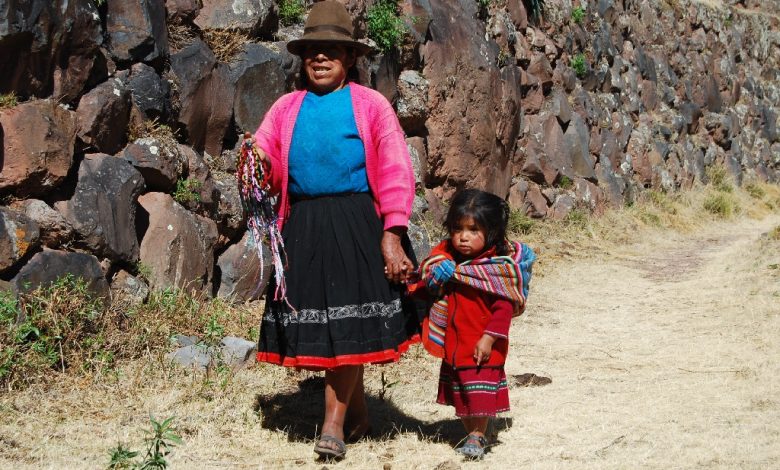
On the way to tourist attractions, such as the fifteenth century Inca estate of Pisaq in the Sacred Valley, you see women offering their wares. They come from communities near the tourist sites and with warmth and sincere smiles captivate the visitors while offering them handicrafts that they made as a souvenir of the place.
Taking advantage of the tourist flow, these women–we call them mamitas, little mothers–come down from their communities alone or sometimes with their children to sell their handicrafts. One of the most popular handicrafts is a woven bracelet that they make while they work. They offer them because the tourists like them but also because they can take them to remember the visitors who travel through on their path.
They have a great variety of bracelets and sell them at a really cheap price, from two to five soles.
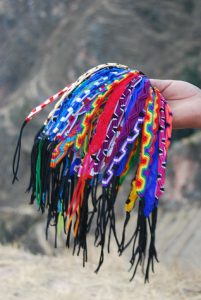
They take up strategic locations where tourists make their way. In the case of the arqueológical site of Pisac, which is on a mountain slope a half hour by car or an hour walking from the town of Pisac, the women are at the entrances waiting for tourists who go up or come down towards the town.
When I walked from the town up towards the archeological park I met a woman and her small daughter. They were waiting for me where the terraces began, those broad steps of stone and earth where the Incas cultivated their crops. Her little daughter stole my heart with her sweetness when she began offering me a variety of bracelets. To see a very young girl who was such a good salesman surprised me. How could I not buy from her, I decided. So I bought two bracelets with different details. On the way down I met another saleswoman with whom I walked down almost the entire path. She was on her way down to buy some goods that they needed in her community.

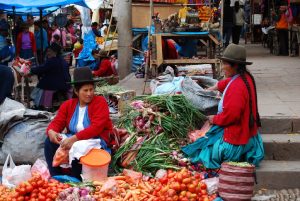
I spoke with one of the vendors who lives in a community close to Pisac and she said she had been selling for many years. Right now tourism is down. People do not buy many bracelets now. The women used to sell much more. She said that they only come to make some money in order to buy things for their families that they cannot produce in their communities.
“We sow main food crops such as potatoes, corn , grains, tarwi and some more. But those products alone can not guarantee our survival.”
Like most of the vendors she wore a pleated skirt, a colorful sweater, and a hat. She had her q’ipi, her cloth-wrapped burden for her back by her side. The queperina, the cloth was handwoven and very colorful. Often it is used to store things she needs and to carry merchandise as well as a baby. Her long hair was divided into two braids and she wore rustic sandals, called ojotas, for walking.
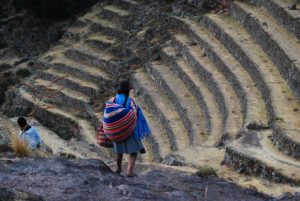
When the sellers of Pisac come down from their communities they not only sell to the tourists, they take advantage of the trip to bring the natural produce from their land in order to exchange it for goods they need and can not grow, such as rice, sugar, oil, and others, in order to feed their families by complementing what they produce.
Like these women from Pisac there are many others in every tourist site. They wait for the tourists in order to recieve them with wamth and offer them their handicrafts.
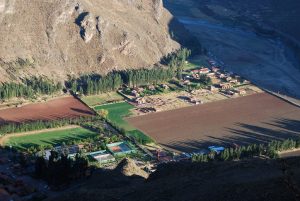
For example, on the road between Cuzco and Pisac there are vendors. We see them on the strategic viewpoints, such as in Corao or Taray. They are attractions on the way to the Sacred Valley where we find them with their handicrafts and some animals from the region such as lambs, llamas, and puppies. They greet all the buses that pass by in order to sell or to let the tourists take photographs of them and with them while the tourists take a stop to see the beauty of the overlook.
At they same time they are vendors, they also are part of the attraction. Tourists love them and they are from the area. Even though time has passed by and many people have changed, they continue wearing traditional dress. As a result we call the cholitas sice they wear the traditional dress of their communities. Together with their children they attract the attention of the tourists so they can sell them their wares.





